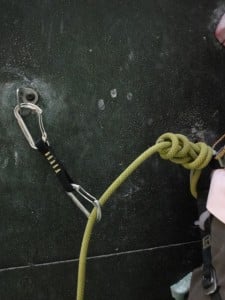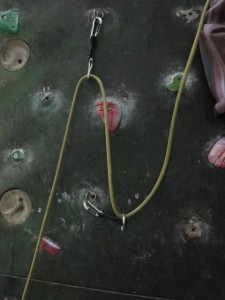Once you have decided you want to learn to sport climb, as well as the kit you already have; harness, helmet, shoes, chalk bag and belay device you will need a rope, quickdraws, two long slings and two screwgate karabiners.
Ropes
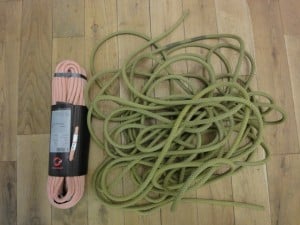
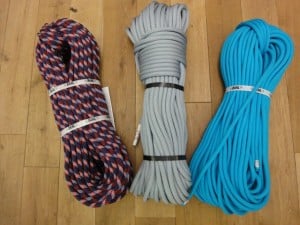
Ropes for sport climbing come in a variety of lengths, but as a general rule you would use a 30m gym rope for indoor and a 60m dynamic rope for outdoor sport lead climbing. Be aware that some indoor climbing centres are higher than 15m and so a 30m rope will not be long enough. It is always wise to ring the centre and check the length of their routes before you visit. Also there are some outdoor sport climbs that are longer than 30m, and you will therefore need a 70m rope. Read the relevant guide books before you venture on these routes or seek local knowledge. However, there are two ways you can ensure you won’t drop the lead climber when lowering and that is either to tie in as second, or tie a knot in the end of the rope.
Single ropes can also vary in thickness between 8.9 and 11 mm. The thinner sport ropes are generally used for travelling by plane to save hold weight but a rope of 10 mm is easier to handle and more suitable for general use. If you do go for a skinnier rope be aware that it will wear quicker, doesn’t perform well over sharp edges, is not suitable for top roping or working routes and you must ensure you have the correct belay device.
Quickdraws
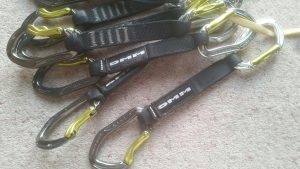
You will often find if you lead indoors that the quickdraws are already in place. Some centres leave a selection of their lead walls without quickdraws and just have the bolt hangars in place so you can learn to place and clip your own. On sport crags outdoors there are no quickdraws in place and you have to provide your own. But what type do you choose and how many? Keeping 16 quickdraws in your rucksack and then choosing to carry as many as needed on the route with a couple to spare is recommended in case you drop one and a leaver karabiner if you have to abandon the route due to its difficulty or bad weather.
I use smooth-nosed, solid gate, snap link DMM Alpha Sport quickdraws for outdoor sport climbing because they are; ergonomically designed to avoid fumble clipping, easy to remove from the harness, easy to unclip from the rope and bolt hangars and have an amazingly powerful closing action that ensures efficient clipping. They are also strong and robust with varying webbing width to ensure the the karabiners sit securely in the crook of the karabiner. They are quite expensive, but you do get what you pay for. You can buy budget quickdraws that are adequate for as little as £8 per quickdraw. Hook Nose Karabiners have a tendency to catch on your harness, the bolts and trap your fingers if you are inexperienced – but they are usually cheaper as manufacturers are moving towards smooth nosed for efficiency.
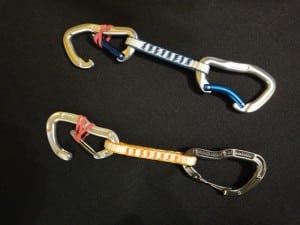
It is worth having a selection of different lengths of tape connecting the two karabiners on your quickdraws in case you need a longer length to negotiate an obstacle, e.g. an overhang.
You may also use shorter tapes when clipping close to the ground to avoid hitting the floor should you fall off.
The two karabiners should be different colours to differentiate between the karabiner that clips the bolt and the karabiner that the rope clips into. The reason for this is that the karabiner that clips the metal bolt will become worn with sharp notches that may abrade the rope if you get them the wrong way round.
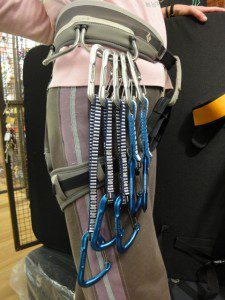
How to orient them is an interesting question, but generally speaking 99% of the time it is best to have the karabiners facing the same way so that the gates can be clipped facing away from the direction of travel.
There is a slight advantage in having them in opposition, but ONLY if the bolt is a long way off to the side, then the gates are in the optimum position to get the most out of your reach.
Correct clipping occurs when the lead climber, in a balanced position is able to clip the karabiner one handed so that the rope to the climber is coming out of the front of the lower karabiner and the rope to the belayer is against the wall/rock face. It is worth practising with both hands whilst still on the floor as you use a slightly different method with each hand, and clipping from the left and the right.
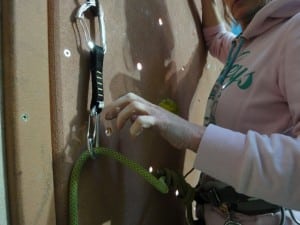
Climbers often clip above their head, which means they pull out more rope to make the clip, which uses up more energy and if they fall off at this point, they will fall further and could even hit the floor, even from as high as 4 bolts up. The optimum position to clip is when the quickdraw is around waist height.
There will be many occasions, however, when you will clip above your head; just make sure you are in a good solid position.
